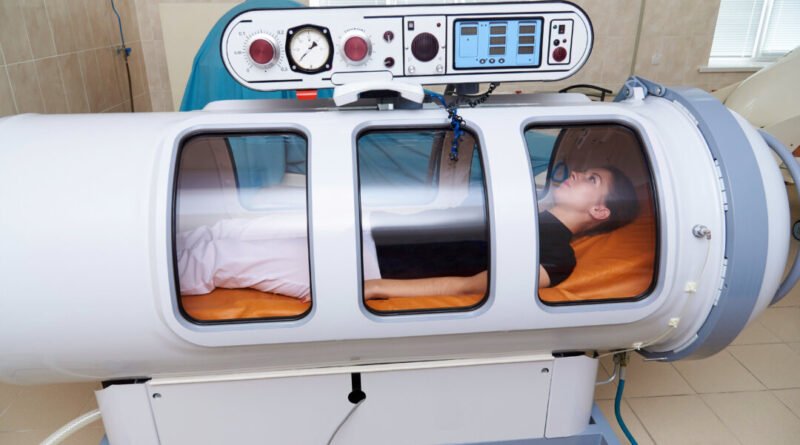The Promising Potential of Hyperbaric Oxygen Therapy in Cancer Treatment
HBOT has the potential to enhance radiation therapy, halt tumor growth, and reduce the debilitating side effects of chemotherapy and radiation. In the quest to find innovative cancer treatments, a remarkable contender has emerged—hyperbaric oxygen therapy. Recent studies are uncovering its potential to not only enhance radiation therapy and halt tumor growth but also reduce the debilitating side effects of cancer treatments such as chemotherapy and radiation, when used as part of treatment or as an adjuvant.
What Is Hyperbaric Oxygen Therapy?
Hyperbaric medical therapy dates back to over 360 years with therapeutic uses documented by a British physician in 1662. Since then it’s been studied extensively and is currently approved by the U.S. Food and Drug Administration (FDA) for specific conditions. Research and clinical trials are ongoing, exploring its potential applications for many other conditions such as COVID-19 and long-COVID. Hyperbaric oxygen therapy (HBOT) consists of “the supply of pure oxygen under augmented pressure,” authors in a 2021 study published in Medicina state. The pure medical grade oxygen, usually close to 100 percent (95 percent or greater) is administered in a controlled chamber or tube-like structure, that creates an atmospheric pressure 1.4 to 3 times higher than normal. For reference, the air we breathe contains about 21 percent oxygen per the FDA. The elevated atmospheric pressure results in the absorption of significantly higher amounts of oxygen into the blood and tissues, facilitating its transfer to damaged organs and tissues. Why It’s Beneficial
Every cell in our body relies on oxygen for survival and well-being, particularly when illness or injury hinders tissue from getting enough oxygen. Related Stories Interestingly, a 2019 article published in Frontiers in Nutrition proposes the controversial opinion that oxygen is conclusively a nutrient and states that it “…[ oxygen ] should be included within the landscape of nutritional science …” The 2021 review published in Medicina explains that hypoxia can happen due to low oxygen in the blood, which can result from issues like poor blood flow to the lungs, problems with airflow to the tiny air sacs in the lungs, or difficulties in oxygen exchange within the lungs. It can also occur because of low blood supply or trouble delivering oxygen to the tissues. The article also notes that while a little bit of hypoxia can be good for our health during early development or when we’re occasionally exposed to it—most of the time, it’s bad for our cells—and can lead to many diseases. That’s why oxygen is considered a potential treatment for people with various short- or long-term health issues. A 2020 article published in The Journal of Biomedical Sciences states that “A growing body of evidence implicates that hypoxia plays critical roles in the pathogenesis of major causes of mortality including cancer, myocardial ischemia, metabolic diseases, chronic heart and kidney diseases, and in reproductive diseases such as preeclampsia and endometriosis.” HBOT offers a solution by providing higher oxygen concentrations to affected areas, ultimately benefiting all cells in the body, although it’s essential to strike the right balance, as excessive oxygen intake can have adverse effects on the body. HBOT and Cancer
Currently, using HBOT as a part of cancer therapy isn’t FDA-approved, but there have been some hopeful findings in recent studies on different types of cancer including leukemia, breast cancer, brain tumors, prostate cancer, head and neck cancer, colorectal cancer, cervical cancer, and bladder cancer, per the Medicina review. The same article outlines that the “Main applications derived from HBOT in oncology may be (a) As part of the treatment (b) as a radiotherapy adjuvant and (c) as a chemotherapy adjuvant.”
Treatment
Although HBOT is not yet approved as a cancer treatment, some studies have shown encouraging results using HBOT as a treatment alone as well as combined with traditional cancer treatments such as chemotherapy and radiation. A 2007 study published in Leukemia Research looked at how HBOT at 2.5 to 3.5 atmospheric pressure with 100 percent oxygen for six hours affected different types of cancer cells in terms of apoptosis, a process of programmed cell death. The researchers used different cell lines, including blood-related cells and non-blood cells. Researchers found that the hematopoietic cells underwent a significant amount of programmed cell death (apoptosis) due to the treatment. The results suggest that hematopoietic cancer cells are more sensitive to oxidative stress induced by high-pressure oxygen treatment than non-hematopoietic cancer cells which leads to cell death. Also, the study noted that the amount of oxygen and the pressure seem to be important factors in causing apoptosis in the cancer cells. A 2005 study published in Anticancer Research tested the impact of HBOT on four specific types of breast cells: normal mammary cells, cells from a primary tumor, MCF7 human mammary adenocarcinoma cell lines, and cells from a tumor that had spread to other parts of the body (metastatic tumor cells). The goal was to see how HBOT influenced the growth of these different types of breast cells. The study found that HBOT inhibited the growth of all four types of breast cells they studied and the effect was more pronounced the longer the cells were exposed to HBOT. Other conditions like high oxygen levels alone or increased atmospheric pressure also slowed down cell growth, but HBOT had the most significant effect. Additionally, they found that HBOT worked even better when combined with certain cancer drugs, making them more effective at inhibiting cell growth. The authors also noted that the inhibitory effects of HBOT were still noticeable two weeks after exposure. Another study conducted in 2010 and published in the journal Cancer Biology & Therapy, found that applying HBOT to mice with ovarian tumors over 21 days led to a notable reduction in tumor growth. In an additional experiment, the researchers took it a step further by combining HBOT therapy with a chemotherapy agent in a separate group of mice. The outcome demonstrated a reduction in tumor volume within two weeks with the combined approach. Another study outlined in the 2021 review in Medicina, found that when used in combination with specific chemotherapy drugs, paclitaxel, carboplatin, and hyperthermia, HBOT showed promising results in treating patients with non-small cell lung cancer and multiple metastases. Mitigating Damage Caused by Radiation and Chemotherapy Radiation therapy is a common treatment for cancer, but it can cause damage to healthy tissues and organs. Almost all tissues affected by these delayed radiation injuries show a specific type of tissue damage that includes low oxygen, poor blood supply, and reduced cell presence according to the Medicina review. Below are documented ways HBOT can help with damage caused by radiation therapy: Endothelial injury and vascular damage: HBOT has been shown to repair damage and promote the growth of new blood vessels as well as endothelial cells that line blood vessels according to Johns Hopkins Medicine literature on HBOT. Vascular disease: HBOT can help reduce the risk of vascular disease by improving blood flow and oxygen delivery to the tissues. A 2021 study in the Impact Journal on Aging found that HBOT had a positive effect on blood vessels in mice with Alzheimer’s disease. The study showed that the diameter of blood vessels in the brain was slightly reduced in these mice, resulting in less blood flow. HBOT helped to widen the narrowed blood vessels, increasing blood flow and reducing hypoxia. This improvement continued for at least two weeks after the HBOT treatment was completed having a lasting positive impact on blood vessels and oxygen levels in the brains of these mice with Alzheimer’s disease per the study. Hypoxia: HBOT can help mitigate the effects of hypoxia by increasing the amount of oxygen delivered to the tissues as noted in the study mentioned above. HBOT is also shown to help mitigate damage from chemotherapy. Some of the documented benefits covered in the Medicina review include: Preventing chemotherapy-induced neuropathy: HBOT has been shown to be effective in preventing chemotherapy-induced neuropathy, which is a common side effect of chemotherapy. Reducing mortality in cancer models: The combination of chemotherapy with HBOT has been found to significantly reduce mortality in animal cancer models, such as osteosarcoma and lung cancer. However, the article stresses that the combined use of HBOT and certain chemotherapy drugs like doxorubicin, bleomycin, or cisplatin may lead to adverse effects, such as cardiotoxicity, pulmonary toxicity, or impaired wound healing. Approved and Unapproved Uses The Undersea & Hyperbaric Medical Society lists current FDA-approved indications for HBOT as: Air and gas bubbles in blood vessels. Anemia (severe anemia when blood transfusions cannot be used). Burns (severe and large burns treated at a specialized…




